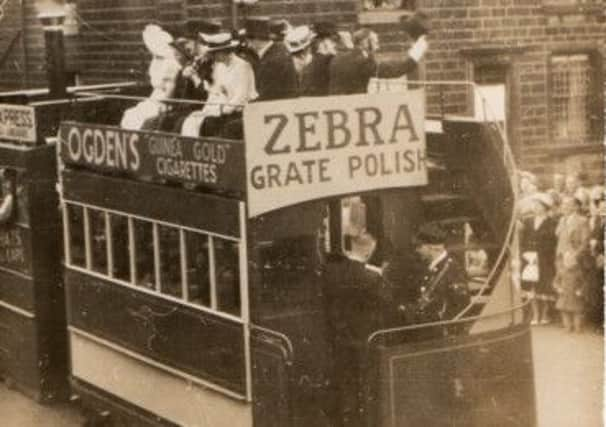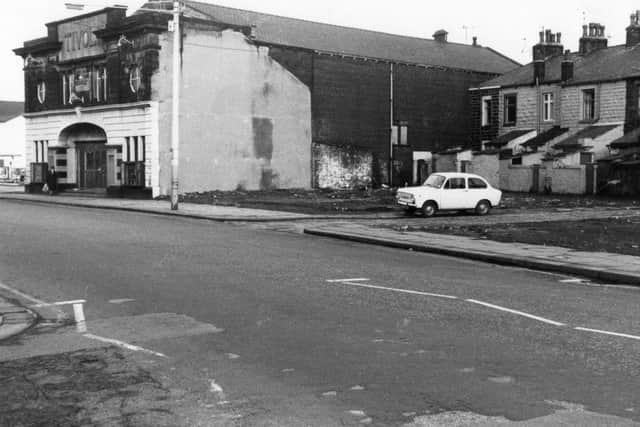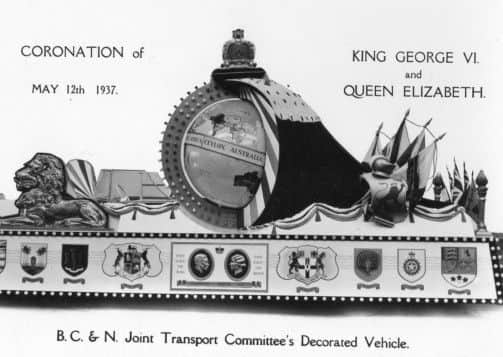Mystery of the Burnley ‘tram’ location is solved!


Although it might look like it, the image is not taken from a postcard. It is photo which appears to be of a Burnley tram of the 1880s and 1890s travelling along a local road, but, if you look closely, things do not appear as they should be.
Whatever, is coming out of the chimney of the “steam engine” or locomotive, left, does not appear to be smoke. The clincher is there are no tramlines behind the tramcar (which appears to be number 1).
Advertisement
Hide AdAdvertisement
Hide AdThen there is a substantial crowd witnessing what is happening. We only get brief glances but the crowd is several people deep and the upper windows of the houses opposite are filled with people. The little girl, bottom left, appears excited about what she is witnessing.


Superficially, the tram looks to be what one might expect of a Burnley tram of the days before 1901 when the system was electrified. Burnley’s trams date from 1880 and, from then to 1901, were powered by steam engines, sometimes termed locomotives. The combination of engine and tramcar you see here was once a familiar sight.
Even the adverts look authentic. The Burnley Express advertised on the original trams, as did Ogden’s, makers of Guinea Gold cigarettes, and Zebra, makers of grate polish. My only problem with the adverts here is they look too clean. Had they been authentic, smoke from the engine, not to mention Burnley’s industrial atmosphere, would quickly discolour them.
Whether the vehicle is authentic or not is one question but another is about where the photo was taken. This is not immediately apparent but I have always assumed it is of somewhere in Burnley and, knowing how the local transport undertaking operated, I have made the assumption the image is taken on one of the routes followed by the town’s early trams.
Advertisement
Hide AdAdvertisement
Hide AdThe trouble is that most of Burnley’s main roads were served by trams. The choice includes Padiham Road, Westgate, St James’ Street, Church Street, Colne Road, Briercliffe Road, Manchester Road and Accrington Road and there were more. There is not enough information on the picture to determine which is depicted.


On the other hand, there are a few clues. The first is that, given that Burnley is a hilly town, the flat nature of this road means we can discount hilly stretches of road like Westgate, Manchester Road and parts of Colne Road. In addition, this road is quite wide, so it might be possible to discount the narrower roads and streets.
The only other clues in determining where we might be are to do with the houses.
Superficially, these properties appear not to be remarkable. They look like standard “two ups, two downs”, this probably being confirmed by the four chimney pots of each property.
Advertisement
Hide AdAdvertisement
Hide AdBut the fact a house has four chimney pots does not always indicate a “two up, two down”. My house, in Harle Syke, was built with six rooms (three up, three down) but there were, originally, only three rooms with fire places and three chimney pots.
As with most Burnley terraced property, these houses are built of stone but there are things which made them, to some extent, distinctive. Look at the door of the second house along. It is topped by a simple stone lintel below which is a glass fan light designed to throw light into what otherwise would have been a dark corridor.
Not taking account of the fan light, at this stage, few terraced houses in Burnley have lintels of this kind. Of course, in recent years, we have lost many houses like the ones shown in the photo but I asked myself, do these houses survive?
My initial thoughts were that it was most likely these houses, if they were in Burnley, were in Colne Road. The first, of several options, was to look at the Allen Street/Lee Street area. The former used to be on north and south sides of Colne Road but it did not take me long to realise neither of these streets, even though they had seen considerable changes, could fit the bill.
Advertisement
Hide AdAdvertisement
Hide AdI next looked at the Ford and Heap Street area, approaching the two streets from Briercliffe Road. Some of the houses in these streets have the stone lintels shown in the picture but the alignment of the streets, especially the Briercliffe Road elevations, do not conform to what can be seen in the picture. At the Colne Road end some of the properties have been demolished but it was also clear these streets were not the ones I wanted.
There are other streets which meet Colne Road at right angles, the salient point about the street in the picture. I decided to drive the length of Colne Road to see if any of these junctions had survived.
I did not have to go far until I got to Ivy Street, a street which I knew well as I attended St John’s RC School as a boy. It was clear that, as Ivy Street today begins at number 8, the first three houses in the row in the picture have been demolished. However, numbers 8 to 16 each have stone lintels over their doors and the street meets Colne Road at right angles.
This must be it, I thought, but I needed to check. The first thing was to see if I had an old map of the Ivy Street area. I had – and what is more the appropriate row in 1912, the year of the publication of the map, originally had eight houses none of which had front gardens, as shown in the photo, and there was a row of four properties built at right angles to the row in Ivy Street.
Advertisement
Hide AdAdvertisement
Hide AdThese four houses were in Colne Road. Although they no longer exist, I knew them very well as my grandfather, Robert Frost, lived in one in the 1950s and 1960s when I, with my brothers and sisters, was at St John’s.
Getting back to the four houses, I decided to look them up in the 1914 Commercial Directory. They constituted 183 to 189, Colne Road after which was the Tivoli Picture Palace and BSP Club at Barden, or Byerden, House. BSP stands for British Socialist Party, the Burnley headquarters of which was in St James’s Hall, in St James’s Street. The secretary in 1914 was D.D. Irving who, in 1918, became Burnley’s first Labour MP.
My grandfather’s shop was next door to the Tivoli. It was a dry cleaners and hat shop known at the Wel-Done Valet Service and I recall the building as being irregular in shape. This is confirmed by the map and those of you who recall the Tivoli will remember that, although it had a frontage to Colne Road, it was built at a slight angle to the road. However, the important thing to note is that all the Colne Road frontages were at right angles to the properties in Ivy Street.
Numbers 2 and 4 Ivy Street are the ones in this picture. Number 2, in 1914, was occupied by Mr Samuel Lord, who was retired, and number 4 by C. Beaumont, a weaver. The other houses provided homes for a hosier, a baker, a yeast dealer, another weaver and the other properties were occupied by retired people.
Advertisement
Hide AdAdvertisement
Hide AdI am satisfied the street in question is Ivy Street which, apart from the loss of numbers 2 to 6, with three houses opposite and Ivy Cottage, which was in Colne Road, remains remarkably intact. We do, however, have the problem about what was going on when the picture was taken. I have to admit I know something about this. Burnley, Colne & Nelson Joint Transport were adept at making exhibition floats in the shape of trams and did this at their Queensgate workshops, further along Colne Road from Ivy Street.
In 1937, they made a decorated vehicle for the Coronation of King George VI and Queen Elizabeth which took place on May 12th. There are also references to them making a full-size version of an original tram engine and tramcar and it is this latter in today’s main photo.
This latter, described as a “mock up” of the old type of steam tram, which ran in Burnley from 1883 to 1901, was built at Queensgate from a 1934 double-decker bus. The vehicle appeared in Burnley’s 1951 Festival of Britain procession and there are photos of it in other parts of Burnley.
Problem solved, I think.